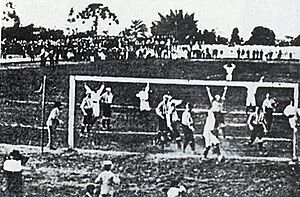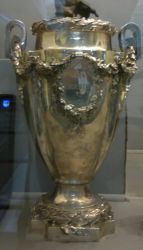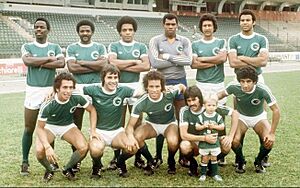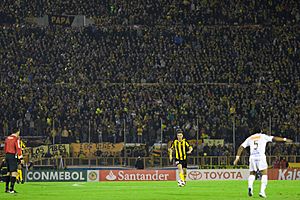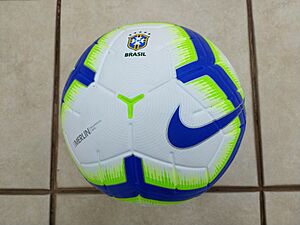Campeonato Brasileiro Série A facts for kids
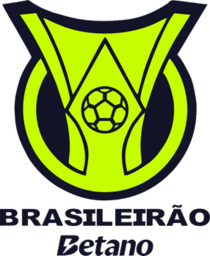 |
|
| Organising body | Brazilian Football Confederation |
|---|---|
| Founded | 1937 (first iteration) 1959 (modern iteration) |
| Country | Brazil |
| Confederation | CONMEBOL |
| Number of teams | 20 (since 2006) |
| Level on pyramid | 1 |
| Relegation to | Série B |
| Domestic cup(s) |
|
| International cup(s) | |
| Current champions | Botafogo (3rd title) (2024) |
| Most championships | Palmeiras (12 titles) |
| Most appearances | Fábio (681) |
| Top goalscorer | Roberto Dinamite (190) |
| TV partners | LIBRA teams TV Globo SporTV Premiere LFU teams Record Amazon Prime Video CazéTV Premiere |
The Campeonato Brasileiro Série A, often called the Brasileirão, is Brazil's top professional association football league. It's the highest level of football in the Brazilian football league system. Twenty clubs compete in the league each year.
Teams can move up or down between the Brasileirão and the Série B (the second division). In 2021, a group called the IFFHS said the Brasileirão was the strongest national league in South America and even the strongest in the world!
Brazil has a unique history with national football competitions. For a long time, the most important games were the state championships. These were played within each Brazilian state.
In 1959, travel became easier, and Brazil needed a team for the new Copa Libertadores tournament. This led to the creation of the Taça Brasil, a national knockout tournament. Later, in 1967, another tournament called the Torneio Roberto Gomes Pedrosa became very popular.
The first tournament officially called a "national championship" by the CBF was in 1971. It was won by Atlético Mineiro.
For many years, the rules and number of teams in the Brazilian Championship changed almost every season. Sometimes, teams didn't even move up or down divisions. In 1979, a huge 92 teams played!
The championship finally got a standard format in 2006. Now, 20 clubs play each other twice, once at home and once away. This is called a round-robin system.
In 2010, the CBF officially recognized the winners of the older tournaments (Taça Brasil and Torneio Roberto Gomes Pedrosa) as Brazilian champions. This means teams like Palmeiras and Santos have many titles from different eras. In 2023, the 1937 Torneio dos Campeões was also recognized as a Brazilian championship.
The Campeonato Brasileiro is one of the strongest leagues globally. Brazilian clubs have won the Club World Cup 10 times and the Copa Libertadores 24 times. It's also the most-watched football league in the Americas. It's broadcast in 155 countries and is one of the richest championships in the world.
Since 1959, 156 clubs have played in the Brasileirão. Seventeen clubs have won the title. Palmeiras has won the most, with twelve titles. Santos is next with eight titles. The state of São Paulo has the most champions, with 34 titles.
Contents
History of Brazilian Football League
Early Football and State Championships
Football came to Brazil in 1894, brought by Charles Miller. He had studied in England and loved the sport. Football quickly became very popular. In 1902, Miller helped start Brazil's first football league, the Liga Paulista de Foot-Ball. This league only played in the São Paulo area.
Because Brazil is so big and travel was difficult, it was hard to create a national league. So, other states started their own state championships. These state leagues were the most important competitions for a long time.
As football grew, different groups started organizing tournaments between states. The Campeonato Brasileiro de Seleções Estaduais was a popular tournament. It featured teams made up of the best players from each state.
The Torneio Rio–São Paulo was another important tournament. It was played between clubs from the São Paulo and Rio de Janeiro state leagues. These two states had the best teams in Brazil.
One of the first attempts at a national club championship was in 1920. It included the winners of the São Paulo, Rio de Janeiro, and Rio Grande do Sul state championships. A second version happened in 1937, won by Atlético Mineiro. This was the first time professional clubs played in such a tournament. In 2023, the CBF officially recognized the 1937 tournament as a Brazilian championship. This made Atlético Mineiro the first national champions of Brazil.
The Taça Brasil and Torneio Roberto Gomes Pedrosa
The Taça Brasil (Brazil Cup) started in 1959 and ran until 1968. It was created to choose a Brazilian team for the new Copa Libertadores de América. The Taça Brasil was a knockout tournament. Teams were chosen from the winners of the state championships. The first champion was Bahia. They beat Pelé's Santos in a big surprise. This win showed that teams outside Rio de Janeiro and São Paulo could also be champions.
In 1967, the Rio de Janeiro and São Paulo football federations decided to make their Torneio Rio–São Paulo bigger. They invited teams from other Brazilian states. This new tournament was called the Torneio Roberto Gomes Pedrosa, or Robertão. Unlike the Taça Brasil, the Robertão used a round-robin system. Teams played each other in groups.
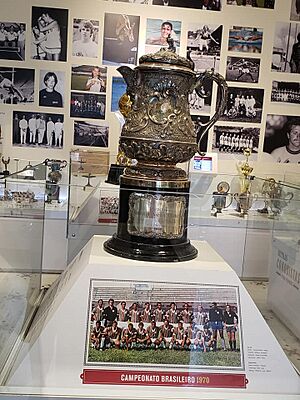
In 1968, the Taça Brasil finished late. So, the CBF used the Robertão to decide which teams would play in the Copa Libertadores. The CBF took over the Robertão and renamed it the "Taça de Prata" (Silver Cup). The Taça Brasil ended after 1968.
In 2010, the CBF announced that both the Robertão and the Taça Brasil winners were official Brazilian champions. This caused some discussion because both tournaments ran at the same time in 1967 and 1968. For example, Palmeiras won both in 1967. In 1968, Botafogo won the Taça Brasil, and Santos won the Robertão. So, both were recognized as champions that year.
National Championship and Copa Brasil
After Brazil won its third World Cup in 1970, the government wanted to improve Brazilian football. They decided to create a new national championship. It would have 20 teams, like European leagues. The first edition in 1971 was called "National Championship of Clubs". Atlético Mineiro won it.
A new second division was also created. However, there was no system for teams to move up or down. Clubs were chosen for each division based on how they did in their state championships.
In the following years, more and more clubs joined the competition. This was partly because the government wanted to gain support across the country. By 1979, a record 92 teams were playing! From 1975 onwards, the competition was officially called Copa Brasil (Brazil Cup).
New Changes and Challenges
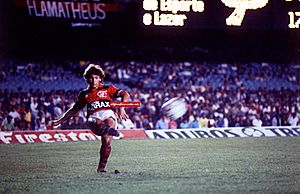
In 1980, the CBF was created. Brazil was also facing financial problems. These changes led to a big reorganization of Brazilian football. The championship became smaller, and a new format was introduced. The 1980 edition was called "Taça de Ouro" (Gold Cup).
The second division, now called "Taça de Prata" (Silver Cup), was brought back. For the first time, a system for teams to move up was introduced. The best teams from the "Taça Prata" could move up to play in the "Taça Ouro". A third division, the "Taça de Bronze" (Bronze Cup), was also created in 1981. But it was stopped after just one year due to money problems.
In 1987, the CBF said it didn't have enough money to organize the championship. So, the thirteen most popular clubs in Brazil formed their own group, called Clube dos 13. They decided to organize their own tournament, called Copa União.
The CBF later tried to make the Copa União part of a bigger tournament. But the Club of the 13 didn't agree. This led to a lot of confusion. In the end, Sport was recognized as the 1987 champion by the CBF and FIFA. However, some fans still believe Flamengo was the true champion that year.
After the problems of 1987, the CBF and Club of the 13 agreed to work together. In 1988, the championship had fewer teams (24) to make it more competitive. Also, for the first time, there was a real system for teams to move up and down divisions, as required by FIFA. The 1989 edition was the first to be called "Série A," like the Italian league.
Modern Era: Round-Robin Format and Growth

The Brazilian Championship used to change its format all the time. But the problems in 2000 showed that a stable system was needed. In 2002, the Clube dos 13 voted to use a round-robin format, like in Europe. This means all teams play each other twice. The team with the most points wins.
The first season with this new system was in 2003. Cruzeiro won that year, also winning the Copa do Brasil and their state championship. This was a big achievement. The number of clubs was later set at 20 in 2006. This format has stayed the same ever since. The top four teams qualify for the Copa Libertadores, and the bottom four teams are relegated to Série B. The season runs from May to December.
In 2008, the CBF created the Série D as a fourth division. This helped more teams from different parts of Brazil compete nationally.
In 2010, the CBF officially recognized the champions of the older tournaments (Taça Brasil and Torneio Roberto Gomes Pedrosa) as Brazilian Champions. This meant some years had two champions. In 2023, the 1937 Torneio dos Campeões was also recognized as a Brazilian championship.
How the Competition Works
Competition Rules
There are 20 clubs in the Brasileirão. During the season, from March to December, each club plays every other club twice. They play once at their home stadium and once at the opponent's stadium. This means each team plays a total of 38 games.
Teams get three points for a win and one point for a draw. They get no points for a loss. Teams are ranked by their total points. If teams have the same points, other rules are used to decide their rank. These rules include:
- Total number of games won.
- Total goal difference (goals scored minus goals against).
- Total goals scored.
- Points in head-to-head matches between the tied teams.
If there is still a tie for the championship, for relegation, or for qualifying for other competitions, a special play-off match is played at a neutral stadium.
Teams can move between divisions. The four teams at the bottom of the Brasileirão are moved down to the Série B. The top four teams from the Série B are moved up to the Brasileirão.
Qualifying for International Tournaments
Since 2016, the top six clubs in the Brasileirão can play in the next Copa Libertadores. The top four teams go straight into the group stage. The fifth and sixth-placed teams enter an earlier round. More teams might qualify for the Libertadores if they win the Copa do Brasil, Copa Sudamericana, or the Copa Libertadores itself.
Clubs that finish from seventh to twelfth place usually qualify for the Copa Sudamericana. The exact number can change based on other competitions.
Brazilian Champions
Seventeen clubs have officially won the Brazilian football championship.
| Rank | Club | Titles | Runner-up | Years won | Years runner-up |
|---|---|---|---|---|---|
| 1 | 12 | 5 | 1960, 1967 (TB), 1967 (RGP), 1969, 1972, 1973, 1993, 1994, 2016, 2018, 2022, 2023 | 1970, 1978, 1997, 2017, 2024 | |
| 2 | 8 | 8 | 1961, 1962, 1963, 1964, 1965, 1968 (RGP), 2002, 2004 | 1959, 1966, 1983, 1995, 2003, 2007, 2016, 2019 | |
| 3 | 7 | 3 | 1990, 1998, 1999, 2005, 2011, 2015, 2017 | 1976, 1994, 2002 | |
| 1980, 1982, 1983, 1992, 2009, 2019, 2020 | 1964, 2018, 2021 | ||||
| 5 | 6 | 6 | 1977, 1986, 1991, 2006, 2007, 2008 | 1971, 1973, 1981, 1989, 1990, 2014 | |
| 6 | 4 | 5 | 1966, 2003, 2013, 2014 | 1969, 1974, 1975, 1998, 2010 | |
| 4 | 1974, 1989, 1997, 2000 | 1965, 1979, 1984, 2011 | |||
| 1 | 1970, 1984, 2010, 2012 | 1937 | |||
| 9 | 3 | 8 | 1975, 1976, 1979 | 1967 (RGP), 1968 (RGP), 1988, 2005, 2006, 2009, 2020, 2022 | |
| 5 | 1937, 1971, 2021 | 1977, 1980, 1999, 2012, 2015 | |||
| 3 | 1968 (TB), 1995, 2024 | 1962, 1972, 1992 | |||
| 12 | 2 | 4 | 1981, 1996 | 1982, 2008, 2013, 2023 | |
| 2 | 1959, 1988 | 1961, 1963 | |||
| 14 | 1 | 2 | 1978 | 1986, 1987 | |
| 1 | 2001 | 2004 | |||
| 0 | 1985 | — | |||
| 1987 | |||||
| — | 0 | 2 | — | 1960, 1968 (TB) | |
| 2 | 2000, 2001 | ||||
| 1 | 1967 (TB) | ||||
| 1985 | |||||
| 1991 | |||||
| 1993 | |||||
| 1996 |
Note: Even though some people think Flamengo won the Brazilian Championship in 1987, Sport is officially the only champion of that competition.
League Names and Sponsors
The Campeonato Brasileiro has had many official names over the years. It finally settled on "Campeonato Brasileiro" in 1989.
| Identity | English name | Years | Official Sponsor |
|---|---|---|---|
| Copa dos Campeões Estaduais | State Champions Cup |
|
None |
| Taça Brasil | Brazil Cup |
|
|
| Torneio Roberto Gomes Pedrosa | Roberto Gomes Pedrosa Tournament |
|
|
| Campeonato Nacional | National Championship |
|
|
| Copa Brasil | Brazil Cup |
|
|
| Taça de Ouro | Golden Cup |
|
|
| Copa Brasil | Brazil Cup |
|
|
| Copa João Havelange | João Havelange Cup |
|
|
| Campeonato Brasileiro | Brazilian Championship |
|
2001: LATAM (Brasileirão TAM) |
League Finances
The Brasileirão makes a lot of money. In 2012, clubs earned over US$1.17 billion. This made it the highest-earning football league in the Americas. It was also the highest outside of Europe's "big five" leagues.
The Brasileirão is also one of the most valuable football leagues in the world. In 2013, its marketing value was over US$1.24 billion. The total worth of all clubs in the 2013 Brasileirão was US$1.07 billion.
Television rights are a huge part of the league's income. In 2012, these rights were worth over US$610 million. This was more than 57% of all TV rights in Latin America.
In 2013, Corinthians was the 16th most valuable club globally. It was worth over US$358 million.
Clubs in the Brasileirão
The following 20 clubs are playing in the Série A for the 2025 season.
| Club | Position in 2024 |
First season in top division |
Number of seasons in top division |
First season of current spell |
Number of seasons of current spell |
Top division titles |
Last top division title |
|---|---|---|---|---|---|---|---|
| Atlético Mineiro | 12th | 1959 | 63 | 2007 | 19 | 3 | 2021 |
| Bahia | 8th | 1959 | 52 | 2023 | 3 | 2 | 1988 |
| Botafogo | 1st | 1962 | 60 | 2022 | 4 | 3 | 2024 |
| Ceará | 4th (Série B) | 1962 | 27 | 2025 | 1 | 0 | N/A |
| Corinthians | 7th | 1967 | 57 | 2009 | 17 | 7 | 2017 |
| Cruzeiro | 9th | 1960 | 62 | 2023 | 3 | 4 | 2014 |
| Flamengoa, b | 3rd | 1964 | 60 | 1967 | 58 | 7 | 2020 |
| Fluminense | 13th | 1960 | 60 | 2000 | 26 | 4 | 2012 |
| Fortaleza | 4th | 1959 | 27 | 2019 | 7 | 0 | N/A |
| Grêmio | 14th | 1959 | 65 | 2023 | 3 | 2 | 1996 |
| Internacional | 5th | 1962 | 59 | 2018 | 8 | 3 | 1979 |
| Juventude | 15th | 1977 | 20 | 2024 | 2 | 0 | N/A |
| Mirassola | 2nd (Série B) | 2025 | 1 | 2025 | 1 | 0 | N/A |
| Palmeiras | 2nd | 1960 | 62 | 2014 | 12 | 12 | 2023 |
| Red Bull Bragantino | 16th | 1990 | 15 | 2020 | 6 | 0 | N/A |
| Santos | 1st (Série B) | 1959 | 64 | 2025 | 1 | 8 | 2004 |
| São Pauloa, b | 6th | 1967 | 58 | 1980 | 46 | 6 | 2008 |
| Sport Recife | 3rd (Série B) | 1959 | 43 | 2025 | 1 | 1 | 1987 |
| Vasco da Gama | 10th | 1959 | 56 | 2023 | 3 | 4 | 2000 |
| Vitória | 11th | 1965 | 41 | 2024 | 2 | 0 | N/A |
a: Clubs that have never been relegated
b: Clubs that have always played in the top division
Most Appearances by Clubs
Many teams have played in the Campeonato Brasileiro over the years. Here are the clubs with the most seasons in the league. Teams in bold are playing in Série A in 2025.
- 65 seasons: Grêmio (2025)
- 64 seasons: Santos (2025)
- 63 seasons: Atlético Mineiro (2025)
- 62 seasons: Cruzeiro (2025), Palmeiras (2025)
- 60 seasons: Botafogo (2025), Flamengo (2025), Fluminense (2025)
- 59 seasons: Internacional (2025)
- 58 seasons: São Paulo (2025)
- 57 seasons: Corinthians (2025)
- 56 seasons: Vasco da Gama (2025)
- 52 seasons: Bahia (2025)
- 48 seasons: Athletico Paranaense (2024)
- 43 seasons: Goiás (2023), Sport Recife (2025)
- 42 seasons: Coritiba (2023)
- 41 seasons: Vitória (2025)
- 36 seasons: Portuguesa (2013)
- 34 seasons: Náutico (2013)
- 29 seasons: Guarani (2010)
- 27 seasons: Ceará (2025), Fortaleza (2025), Paysandu (2005)
- 24 seasons: Ponte Preta (2017), Santa Cruz (2016)
- 20 seasons: Juventude (2025)
- 19 seasons: América (MG) (2023), America (RJ) (1988), CSA (2019)
- 17 seasons: Figueirense (2016)
- 16 seasons: Desportiva (1993), Nacional (AM) (1986), Paraná (2018), Remo (2000)
- 15 seasons: América (RN) (2007), Red Bull Bragantino (2025)
- 14 seasons: ABC (1985), Atlético Goianiense (2024), Criciúma (2024)
- 13 seasons: Rio Branco (ES) (1987)
- 12 seasons: Joinville (2015), Sampaio Corrêa (1986), Sergipe (1986)
- 11 seasons: Avaí (2022), Bangu (1988), Campinense (1981), CRB (1984), Moto Club (1984)
- 10 seasons: Operário (MS) (1986)
- 9 seasons: Chapecoense (2021), Treze (1987), Vila Nova (1985)
- 8 seasons: Americano (1983), Confiança (1984), Mixto (1985), Ríver (1982)
- 7 seasons: Botafogo (PB) (1986), Brasília (1985), Flamengo (PI) (1985), Inter de Limeira (1990), Londrina (1982), Rio Negro (AM) (1983), São Caetano (2006)
- 6 seasons: Botafogo (SP) (2001), Comercial (MS) (1986), Ferroviário (CE) (1984), Gama (2002), Goytacaz (1979), Grêmio Maringá (1982), Uberaba (1983)
- 5 seasons: Colorado (PR) (1983), Itabaiana (1982), Metropol (SC) (1968), Tiradentes (PI) (1983)
- 4 seasons: Anapolina (1984), Brasil de Pelotas (1985), Caxias (1979), Cuiabá (2024), Fluminense de Feira (1979), Goiânia (1979), Operário (MT) (1986), Piauí (1986), Tuna Luso (1986), Uberlândia (1985), União São João (1997)
- 3 seasons: Alecrim (1986), CEUB (1975), Dom Bosco (1979), Fast Clube (1979), Ferroviário (PR) (1967), Fonseca (1963), Leônico (1985), Maranhão (1980), Pinheiros (PR) (1985), Rabello (1969), São Paulo (RS) (1982), Villa Nova (MG) (1985), Volta Redonda (1978), XV de Piracicaba (1979)
- 2 seasons: América (SP) (1980), Campo Grande (RJ) (1983), Capelense (1962), Central (1986), Comercial (SP) (1979), Galícia (1983), Grêmio Barueri (2010), Itabuna (1979), Olaria (1974), Santa Cruz (SE) (1961), Santo André (2009), Santo Antônio (ES) (1962), São José (SP) (1990), XV de Jaú (1982)
- 1 season: Alliança de Campos (1937), América (CE) (1967), América de Propriá (1967), Anápolis (1966), ASA (1979), Auto Esporte (PB) (1959), Auto Esporte (PI) (1984), Brasiliense (2005), Caldense (1979), Catuense (1984), AA Colatina (1979), Comercial (PR) (1962), Corumbaense (1973), Cruzeiro do Sul (DF) (1964), Defelê (1963), Eletrovapo (RJ) (1965), Estrela do Mar (PB) (1960), Ferroviária (1983), Ferroviário (MA) (1959), Francana (1979), Guanabara (DF) (1965), Guará (1979), Hercílio Luz (1959), Inter de Lages (1966), Inter de Santa Maria (1982), Ipatinga (2008), Itumbiara (1979), J. Malucelli (2000), Juventus (SP) (1983), Liga da Marinha (1937), Mirassol (2025), AD Niterói (1959), Noroeste (1978), Novo Hamburgo (1979), Olímpico (AM) (1968), Olímpico (SC) (1965), Operário Ferroviário (1979), Paula Ramos (1960), Perdigão (1967), Potiguar de Mossoró (1979), Rio Branco (RJ) (1962), São Bento (1979), Siderúrgica (1965), Sobradinho (1986), Taguatinga (1982), Vitória (ES) (1977)
Media Coverage
Television money is very important for Brazilian football clubs. The main company that broadcasts the games is Grupo Globo. They show live matches on their TV channels: TV Globo (free TV), SporTV (pay TV), and Premiere (pay-per-view). Subscribers to Premiere can watch all 380 league matches each year.
Globo first showed the league in 1987. The first TV contract was for $3.4 million. In 1990, another channel, Rede Bandeirantes, showed the games. This was when Corinthians won their first national title. Many people watched, which made Globo want to broadcast the league more from 1991.
In 1997, live matches started to be restricted in the cities where they were played. This meant you couldn't watch the game live on TV if you were in the same city as the stadium. The Club of the 13 signed a contract with Globo for $50 million. This was also the first time games were shown on pay-per-view.
In 2000, Globo bought the rights to the Copa João Havelange for $50 million. However, in the 2001 final, Vasco da Gama showed the logo of a rival TV station, SBT. This was a bit awkward for Globo, who was showing the final exclusively.
In 2001, the Club of the 13 divided clubs into four groups for TV money. The most popular teams like Flamengo and Corinthians got the most money. In 2003, the amount of money increased a lot, going over $100 million per year. This happened after the new points-based format was adopted.
In 2009, for the first time, TV rights were sold through an open bidding process. Globo won the biggest TV contract in Brazilian football history: $1.4 billion for 2009–2011.
In 2012, the exact amounts for TV rights were not clear. But it was known that clubs were still divided into groups, with Flamengo and Corinthians getting the most money.
In 2016, Bandeirantes stopped showing league matches, leaving Globo as the only channel. However, another group, Turner Network Television, made a deal with some clubs for cable TV rights from 2019 to 2024.
In February 2021, the streaming service Paramount+ announced it would broadcast 350 matches.
Flamengo and Corinthians, the two most popular teams in Brazil, get about 25% of all TV money. Flamengo has the biggest budget.
Match Ball
Since 1999, the official ball for the Brazilian league has been made by Nike. Before that, brands like Umbro and Topper supplied the balls. The newest ball is called CBF Nike Brasil Flight 2025.
Attendance at Games
The number of fans who attend Campeonato Brasileiro Série A games can vary. Football is very popular in Brazil, but attendance figures have changed over the years.
Since 1967, the average attendance has gone up and down. The 2023 season had the highest average attendance with 26,502 fans per game. The lowest was in 2004, with only 7,556 fans on average.
Compared to other football leagues around the world, the Campeonato Brasileiro Série A was ranked seventh in attendance in 2023. The smallest attendance ever was a game between Juventude and Portuguesa in 1997, with only 55 fans. The largest was a game between Flamengo and Santos in 1983, with 155,523 people!
In 2014, the average attendance was 16,337. The average ticket price was $12.82.
Here are the attendance figures for the league since 2009:
| Season | Overall | Average | Best supported club | Average | Highest attendance |
|---|---|---|---|---|---|
| 2009 | 6,764,380 | 17,801 | Flamengo | 41,553 | 78,639 (Flamengo 2–1 Grêmio) |
| 2010 | 5,638,806 | 14,839 | Corinthians | 27,446 | 76,205 (Vasco da Gama 2–2 Fluminense) |
| 2011 | 5,572,673 | 14,664 | 29,328 | 63,871 (São Paulo 1–2 Flamengo) | |
| 2012 | 4,928,827 | 13,148 | 25,222 | 62,207 (São Paulo 2–1 Náutico) | |
| 2013 | 5,681,551 | 14,951 | Cruzeiro | 28,911 | 63,501 (Santos 0–0 Flamengo) |
| 2014 | 6,208,190 | 16,337 | 29,678 | 58,627 (São Paulo 2–0 Cruzeiro) | |
| 2015 | 6,376,693 | 17,050 | Corinthians | 34,150 | 67,011 (Flamengo 0–2 Coritiba) |
| 2016 | 5,975,926 | 15,809 | Palmeiras | 32,684 | 54,996 (São Paulo 2–2 Chapecoense) |
| 2017 | 6,238,797 | 16,418 | Corinthians | 40,043 | 50,116 (Grêmio 0–1 Corinthians) |
| 2018 | 7,584,444 | 19,959 | Flamengo | 50,965 | 62,994 (Flamengo 1–2 Athletico Paranaense) |
| 2019 | 8,067,663 | 21,230 | 55,025 | 65,649 (Flamengo 1–0 CSA) |
Players and Records
Most Appearances
These players have played the most games in the Campeonato Brasileiro.
| Rank | Player | Apps |
|---|---|---|
| 1 | Fábio | 800 |
| 2 | Rogério Ceni | 575 |
| 3 | Diego Souza | 468 |
| 4 | Leonardo Moura | 497 |
| 5 | Wellington Paulista | 442 |
| 6 | Paulo Baier | 429 |
| 7 | Fábio Santos | 438 |
| 8 | Zinho | 371 |
| 9 | Cássio | 370 |
| 10 | Clemer | 368 |
| Ramon | 368 |
Top Goal Scorers
These players have scored the most goals in the Campeonato Brasileiro.
| Rank | Player | Goals |
|---|---|---|
| 1 | Roberto Dinamite | 190 |
| 2 | Fred | 158 |
| 3 | Romário | 154 |
| 4 | Edmundo | 153 |
| 5 | Zico | 135 |
| 6 | Diego Souza | 131 |
| 7 | Túlio | 129 |
| 8 | Serginho Chulapa | 127 |
| 9 | Washington | 126 |
| 10 | Luis Fabiano | 117 |
Notes:
- All players are Brazilian, unless noted otherwise.
- Italics means the player is still playing professional football.
- Bold means the player is still playing in the Brazilian Série A.
Assists Each Season
Here are the players who made the most assists (passes that lead to a goal) each season:
- 2024 - Rodrigo Garro (Corinthians) - 11
- 2023 - Hulk (Atlético-MG) & Luis Suárez (Grêmio) – 11
- 2022 - Gustavo Scarpa (Palmeiras) – 12
- 2021 - Gustavo Scarpa (Palmeiras) – 13
- 2020 - Giorgian de Arrascaeta (Flamengo), Keno (Atlético-MG) & Vinicius (Ceará) – 9
- 2019 - Giorgian de Arrascaeta (Flamengo) – 14
- 2018 - Dudu (Palmeiras) – 13
- 2017 - Gustavo Scarpa (Fluminense) – 12
- 2016 - Dudu (Palmeiras) & Gustavo Scarpa (Fluminense) – 10
- 2015 - Jadson (Corinthians) – 14
- 2014 - Éverton Ribeiro (Cruzeiro) – 11
- 2013 - Éverton Ribeiro (Cruzeiro) – 11
- 2012 - Ronaldinho (Atlético-MG) – 13
- 2011 - Danilo (Corinthians) & Elkeson (Botafogo) – 11
- 2010 - Dario Conca (Fluminense) – 19
- 2009 - Cleiton Xavier (Palmeiras) – 14
- 2008 - Júlio César (Goiás), Marquinho (Figueirense) & Patrício (Portuguesa) – 11
- 2007 - Jorge Wagner (São Paulo) – 15
- 2006 - Tcheco (Grêmio) – 12
- 2005 - Edmundo (Figueirense), Jadíson & Paulo Baier (Goiás) – 11
- 2004 - Cicinho (São Paulo) – 13
- 2003 - Alex (Cruzeiro) – 15
Awards and Trophies
The main award for the league is the Prêmio Craque do Brasileirão. Placar magazine gives out the Bola de Ouro, which is the oldest award. The newspapers Lance! give out the Troféu Osmar Santos and the Troféu João Saldanha awards.
See also
 In Spanish: Campeonato Brasileño de Serie A para niños
In Spanish: Campeonato Brasileño de Serie A para niños
- Campeonato Brasileiro Série B, the second division of Brazilian football
- Campeonato Brasileiro Série C, the third division of Brazilian football
- Campeonato Brasileiro Série D, the fourth division of Brazilian football
- Copa do Brasil, the main knockout football competition in Brazil
- History of football in Brazil
- Campeonato Brasileiro de Futebol Feminino Série A1, the main women's Brazilian football league


